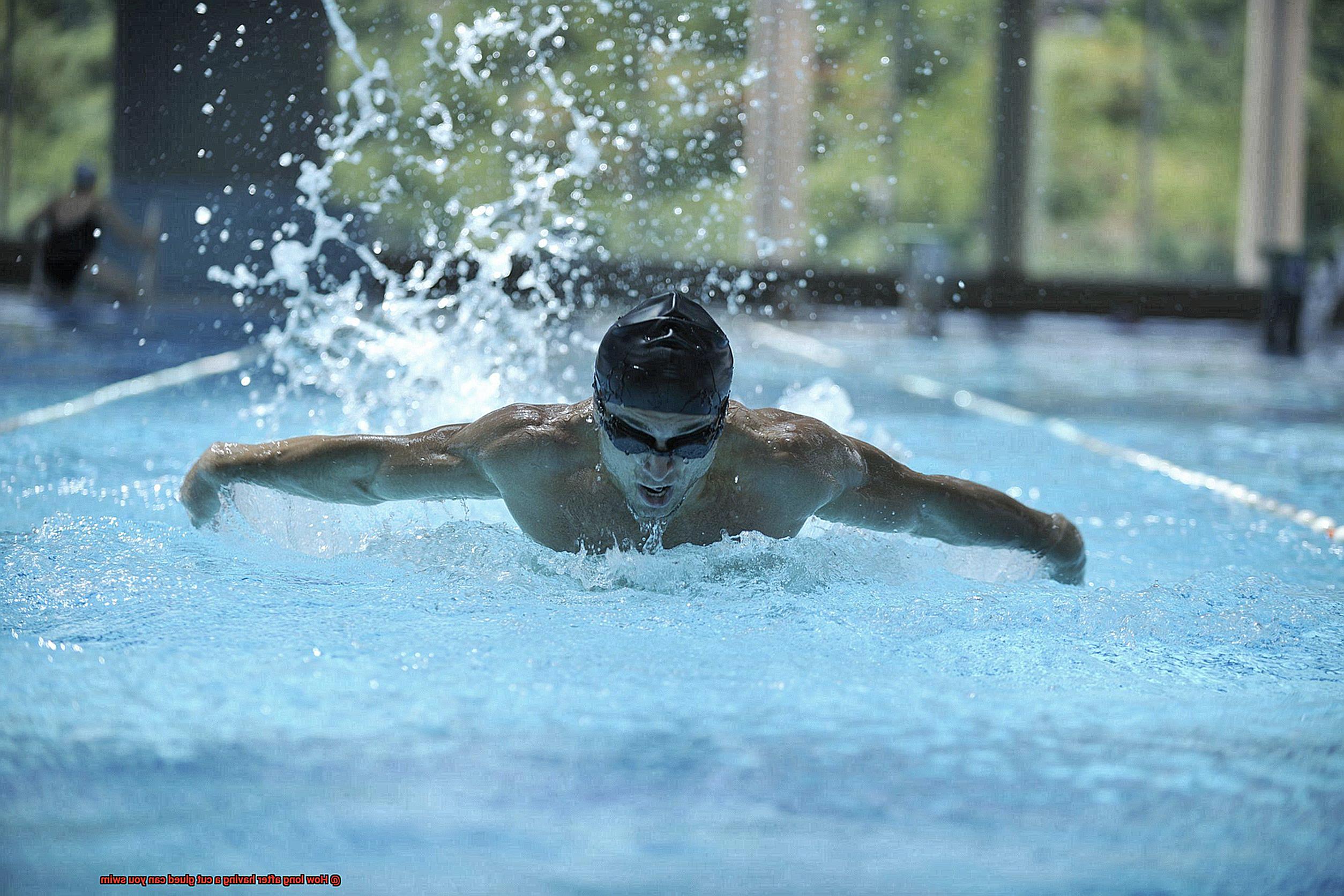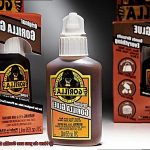Are you itching to dive into a pool or ride the waves at the beach after getting a cut glued?
Well, hold your horses (or should I say, dolphins) for just a moment. We all know that swimming with an open wound can be risky business.
But how long do you really need to wait before taking the plunge? Don’t worry, my water-loving friend, because today we’re going to tackle this burning question head-on.
So grab your sunscreen and get ready to learn all about wound care and when it’s safe to swim again.
The Adhesive Used in Medical Glue
Contents
- 1 The Adhesive Used in Medical Glue
- 2 The Purpose of Using Glue to Close a Wound
- 3 Swimming with a Freshly Glued Wound: Risk of Infection
- 4 General Consensus Among Healthcare Professionals on When to Swim After Having a Cut Glued
- 5 Keeping the Wound Clean and Dry During the Healing Process
- 6 Waterproof Dressings or Bandages for Covering the Wound While Swimming
- 7 Risk of Water Seeping Through Coverings and Compromising the Wound’s Integrity
- 8 Monitoring the Wound for Signs of Infection
- 9 Conclusion
Medical glue, also known as surgical glue or skin glue, is a fascinating adhesive that plays a crucial role in the medical field. In this article, we will explore the advantages and limitations of medical glue and provide guidelines on swimming after having a cut glued.
Advantages of Medical Glue:
Medical glue offers several advantages in wound closure:
- Cosmetically pleasing results: When applied, medical glue forms a thin, flexible film over the wound, promoting better healing outcomes and minimizing scarring.
- Quick and easy application: Applying medical glue is a simple and time-efficient process, making it ideal for minor cuts and wounds.
- Biocompatibility: The adhesive used in medical glue is non-toxic and well-tolerated by patients, ensuring it does not cause harm to the body.
- Water resistance: Medical glue is resistant to water, making it suitable for wounds that may come into contact with moisture, such as those on the hands or feet.
Limitations of Medical Glue:
While medical glue offers numerous advantages, it does have some limitations:
- Unsuitable for deep or uneven wounds: Medical glue may not be appropriate for wounds with irregular edges or those that require deeper closure. In such cases, sutures or stitches may be more effective.
- Gradual breakdown: Over time, medical glue breaks down as the wound heals, eventually falling off or requiring removal by a healthcare professional.

Swimming After Having a Cut Glued:
When considering swimming after having a cut glued, it is crucial to exercise caution and follow these guidelines:
- Wait until the wound has fully healed: To prevent the risk of infection or reopening the wound, it is recommended to wait until the cut has completely healed before swimming. This typically takes about 7-10 days but may vary based on individual healing factors.
- Keep the wound clean and dry: During the healing period, it is crucial to keep the glued wound clean and dry. Moisture from swimming pools or natural bodies of water can interfere with the healing process.
- Consider waterproof dressings or bandages: If swimming cannot be avoided, use waterproof coverings to protect the glued wound adequately. However, even with these precautions, there is still a risk of water seeping through and compromising the wound’s integrity.
- Monitor for signs of infection: Regularly inspect the wound for any signs of infection, such as increased redness, swelling, warmth, or discharge. If these symptoms occur, seek medical attention promptly.
The Purpose of Using Glue to Close a Wound
In the ever-evolving field of medicine, innovative techniques are constantly being developed to improve patient outcomes. One such technique is the use of medical glue for wound closure. In this article, we will explore the purpose of using glue to close a wound and discuss its advantages over traditional sutures or stitches. Additionally, we will delve into various medical scenarios where glue has been successfully utilized.
The Purpose of Using Glue:
Efficient Application:
The primary purpose of using glue for wound closure is to expedite the healing process. Unlike traditional sutures that require time-consuming application, medical adhesive can be applied swiftly and easily. This not only saves valuable time for both patients and medical professionals but also allows for faster wound closure.
Secure Closure:
Glue forms a strong bond between the wound edges, providing a secure closure that holds everything in place during the healing process. This minimizes the risk of wound disruption or complications, ensuring optimal healing.
Waterproof Seal:
One of the unique advantages of using glue is its ability to create a waterproof seal. This prevents moisture from entering the wound, reducing the risk of infection and promoting faster healing. Whether it’s a minor cut or a surgical incision, the waterproof seal created by glue acts as a protective barrier against external contaminants.
Minimized Scarring:

Another significant advantage of using glue for wound closure is its ability to minimize scarring. By holding the wound edges together, it ensures proper alignment during the healing process, resulting in less visible scarring. This is particularly beneficial for wounds in cosmetically sensitive areas or those requiring aesthetic outcomes.
Gradual Dissolution:
Unlike traditional sutures that need to be removed, medical glue gradually dissolves or falls off as the wound heals. This eliminates the need for suture removal appointments, providing greater convenience for patients. The gradual dissolution of glue also minimizes trauma to the healing wound.
Applications of Glue in Medical Scenarios:
Emergency Medicine:
In emergency settings, where time is critical, glue is often used for simple lacerations or cuts that do not require extensive suturing. Its quick application allows for rapid wound closure, enabling healthcare professionals to attend to other urgent matters.
Pediatric Care:
Children often fear needle sticks and the pain associated with sutures. The use of glue in pediatric care provides a less traumatic experience for children, reducing anxiety and improving compliance with wound care instructions.
Cosmetic Surgery:
In cosmetic surgery or dermatology procedures, where optimal aesthetic outcomes are crucial, glue is frequently used for wound closure. Its ability to minimize scarring and provide a secure closure aligns with the goals of these specialties.
Swimming with a Freshly Glued Wound: Risk of Infection
Picture this: the sun is blazing, the water is beckoning, and you’ve recently had a wound glued shut. The temptation to take a refreshing dip may be strong, but before you dive headfirst, it’s essential to understand the risks involved and how long it takes for a wound to heal completely.
Swimming with a freshly glued wound can significantly increase the risk of infection. Why? Because lurking beneath the calm surface of the water are bacteria just waiting for an opportunity to invade your vulnerable wound.
While the glue provides some protection, it may not create an impenetrable barrier. The water in swimming pools, lakes, or oceans can contain a myriad of microorganisms that pose a threat to your healing process. Infections are not only painful but can also lead to complications and delay the overall healing time.
So how long should you wait before taking that exhilarating plunge? On average, it takes about 5-10 days for a glued wound to heal completely. However, keep in mind that healing time can vary depending on factors such as the size and depth of the wound, as well as individual healing capabilities.
During this crucial healing period, it’s vital to keep the wound clean and dry. Avoid exposing it to water as much as possible to promote optimal healing and prevent any potential infections from taking hold.
If you’re unsure whether your wound is ready for swimming, seeking guidance from a healthcare professional is always the best course of action.
General Consensus Among Healthcare Professionals on When to Swim After Having a Cut Glued
Imagine a scorching summer day, and the irresistible urge to dive into cool, refreshing waters. You recently had a cut glued.
Can you still take the plunge? Let’s explore the general consensus among healthcare professionals on when it is safe to swim after having a cut glued.
Types of glue used for cuts:

Healthcare professionals typically use medical-grade adhesives specially formulated for wound closure. These adhesives create a temporary shield against bacteria and contaminants, promoting faster healing.
However, not all glues are suitable for cuts, so it is essential to seek appropriate medical attention.
Time frame for swimming after a cut is glued:
The general consensus among healthcare professionals is to wait at least 24 to 48 hours after having a cut glued before swimming. This waiting period allows the glue to dry and firmly adhere to the skin, ensuring optimal wound closure.
However, personalized guidance from a healthcare professional is necessary as the waiting time may vary depending on factors such as the size and location of the cut.
Swimming in pools, lakes, or other bodies of water can introduce bacteria into the wound, significantly increasing the risk of infection. Even chlorinated pools may not fully eliminate bacteria that can harm an open wound. Therefore, it is crucial to avoid swimming until your wound has completely healed.
If swimming cannot be avoided, there are precautions you can take. Utilizing waterproof bandages or dressings provides an additional layer of protection for the wound while indulging in water activities. Nonetheless, it is still advisable to consult with a healthcare professional before engaging in any water-related activities.
Keeping the Wound Clean and Dry During the Healing Process
When it comes to healing a wound, one of the most crucial steps you can take is keeping it clean and dry. This not only helps prevent infection but also promotes proper healing. So, how exactly do you go about ensuring your wound stays clean and dry? Let’s dive in.
First and foremost, before you even think about touching your wound, make sure to wash your hands thoroughly with soap and water or use hand sanitizer. This simple step helps minimize the risk of introducing bacteria into the wound, which can lead to infection. Remember, clean hands are crucial.
Once your hands are squeaky clean, it’s time to clean the wound itself. You can gently rinse it with clean water or use a mild saline solution. Avoid using harsh antiseptics or hydrogen peroxide, as they can actually damage healthy tissue and delay the healing process. After cleaning, pat the wound dry with a clean, sterile gauze or towel. Be gentle and avoid rubbing the area, as this can irritate the wound and disrupt the healing process.
Now that your wound is clean and dry, it’s time to protect it from external contaminants and further injury. You can apply an appropriate dressing or bandage over the wound. Make sure to change the dressing regularly, following your healthcare provider’s instructions or as needed if it becomes wet, dirty, or starts to smell. This helps maintain a clean and dry environment for the wound to heal.
While keeping a wound clean and dry is crucial, it’s equally important to keep an eye out for any signs of infection. Watch for redness, swelling, increased pain, or pus discharge. If you notice any of these symptoms, seek medical attention promptly.
Now let’s talk about glue and how it can help in this process. Gluing a wound closed can provide an effective barrier against bacteria and debris. It acts like a shield, keeping the wound clean and reducing the risk of infection.
However, it’s important to note that even if your wound has been glued, you should still avoid submerging it in water until it has fully healed.
This means no swimming pools, hot tubs, lakes, or oceans. Water exposure can increase the risk of infection. If you need to bathe or shower, make sure to securely cover the wound with a waterproof dressing or plastic wrap to keep it dry.
Before you jump into the water, it’s essential to follow your healthcare provider’s instructions regarding when it is safe to swim after getting a cut glued. Factors such as the size and location of the wound, as well as your overall health, will be considered. Consulting with a healthcare professional is always recommended to ensure you are taking the necessary precautions.
Waterproof Dressings or Bandages for Covering the Wound While Swimming
When it comes to swimming with a wound, selecting the right waterproof dressing or bandage is crucial. Not only does it protect your wound from getting wet, but it also helps prevent infections and promotes faster healing. In this article, we’ll dive into the importance of choosing an appropriate waterproof dressing and provide you with some tips on how to apply them effectively.
Types of Waterproof Dressings:

Waterproof dressings come in various shapes and sizes to accommodate different types of wounds. From small adhesive strips to larger coverings, these dressings are designed with special materials that repel water and keep your wound dry. Transparent dressings are particularly handy as they allow you to monitor the wound without having to remove the dressing.
Proper Application:
Before applying a waterproof dressing, thoroughly clean your wound and apply any recommended antiseptic or ointment. This helps prevent infection and ensures proper healing. With clean hands, carefully apply the dressing, smoothing out any wrinkles or air bubbles for optimal adhesion. Remember to change the dressing regularly, especially if it becomes wet or dirty, to avoid complications.
Risks of Non-Waterproof Products:
Using non-waterproof dressings or bandages can lead to serious risks. Moisture can seep into the wound, providing a breeding ground for bacteria and increasing the risk of infection. Additionally, moisture can soften the surrounding skin, causing the dressing to peel off prematurely and leaving the wound exposed to further damage.
Alternative Solutions:
In some cases, certain areas of the body may be difficult to cover with traditional waterproof dressings. In such situations, consider using waterproof tape or specialized wound sealants recommended by healthcare professionals. These alternatives provide additional protection against water infiltration and can be tailored to individual needs.
Consult with a Healthcare Professional:
If you have recently had a wound sealed or glued, it’s crucial to consult with a healthcare professional before swimming. They can provide specific advice based on your situation and guide you on the best course of action to ensure proper wound care and healing.
Risk of Water Seeping Through Coverings and Compromising the Wound’s Integrity
Today, we plunge into the depths of the risk posed by water seeping through wound coverings and jeopardizing the integrity of the wound. So grab a towel and let’s embark on this important journey.
Understanding the Waterproof Dilemma:
When a wound is sealed with glue, it is imperative to keep it protected and dry for optimal healing. But wait, isn’t glue supposed to be waterproof? Well, yes and no. While the adhesive used to close your wound is indeed water-resistant, it is not impervious to the cunning ways of H2O.
Unwanted Water Intrusion:
Excessive exposure to water, such as swimming or showering, can elevate the chances of water sneaking past the glue and reaching the vulnerable wound. And trust me, you don’t want uninvited bacteria gatecrashing your healing party or delaying the entire process.
The Role of Coverings:
To ward off aquatic troubles, we depend on coverings like bandages or adhesive films. These act as an additional barrier against water penetration. However, don’t expect them to be flawless seals. Over time or with repeated contact with water, their effectiveness may dwindle. It’s akin to expecting your beloved umbrella to withstand a hurricane – an unrealistic hope.
Importance of Professional Guidance:
Now comes the crucial part: follow your healthcare professional’s instructions. They possess the knowledge and expertise to guide your healing process. They might recommend keeping your wound dry for a specific period. Attempting to swim before that time is akin to playing with fire (or should I say water?).
Factors Influencing Risk:
Several factors influence the risk of water seeping through coverings and compromising wound integrity. The size and location of the wound, type of glue used, quality of the covering, and individual healing quirks all play a role. Not all glued cuts are equal when it comes to water exposure.
Minimizing Splash-Induced Disasters:
Fear not. We have some tips to minimize the impact of water intrusion. Firstly, refrain from swimming or immersing your wound until it has fully healed and the glue has set. Better safe than soggy, right? And when in doubt, always consult your healthcare professional for specific guidance on when it’s safe to take a dip.
Specialized Solutions:
For persistent wounds that resist cooperation, waterproof dressings or specialized wound coverings can become your secret weapon. These remarkable tools create a watertight seal, reducing the risk of infection and expediting the healing process. Think of them as superhero capes for your wounds.
Monitoring the Wound for Signs of Infection
The process of monitoring a wound for signs of infection is a critical component of the healing journey. By carefully observing and recognizing the red flags, we can prevent uninvited bacteria from crashing our healing party. Let’s delve into the comprehensive guide to monitoring wound infections:
Increased Redness:
While some redness is expected during the initial stages of healing, heightened or spreading redness beyond the wound’s immediate vicinity may indicate infection. It’s essential to be mindful of any significant changes in redness.
Swelling and Pain:
Instead of gradually improving, if the wound becomes increasingly swollen or painful, it may signify an infection. This abnormal development should not be ignored and requires attention.
Discharge Drama:
A small amount of clear or slightly yellowish fluid is normal during the healing process. However, excessive discharge that is thick, greenish, or foul-smelling might suggest an infection. Such discharge can result from pus formation caused by the body’s immune response to bacteria.
Temperature Trouble:
An infected wound tends to feel warmer than the surrounding skin due to the body’s inflammatory response to infection. Pay close attention to any noticeable temperature differences around the wound area.
Sensation Story:
Changes in sensation near the wound should not be overlooked. Numbness or tingling might indicate nerve damage or compromised blood flow associated with infection. Prompt medical attention is necessary if these sensations occur.
Systemic Symptoms:
If you experience fever, chills, fatigue, or an increased heart rate alongside signs of local infection, it’s crucial to seek immediate medical attention. These systemic symptoms suggest a more severe infection that requires professional care.
vDLrxILRwfA” >
Conclusion
Swimming enthusiasts, take heed. While you may be itching to dive back into those refreshing waters after having a cut glued, it’s crucial to exercise caution and prioritize your health.
By allowing your body ample time – typically around 24-48 hours – to heal and recover, you’re ensuring that you can make a splash without any setbacks.
Remember, this waiting period gives that trusty adhesive enough time to work its magic, forming an impermeable barrier over your wound.






